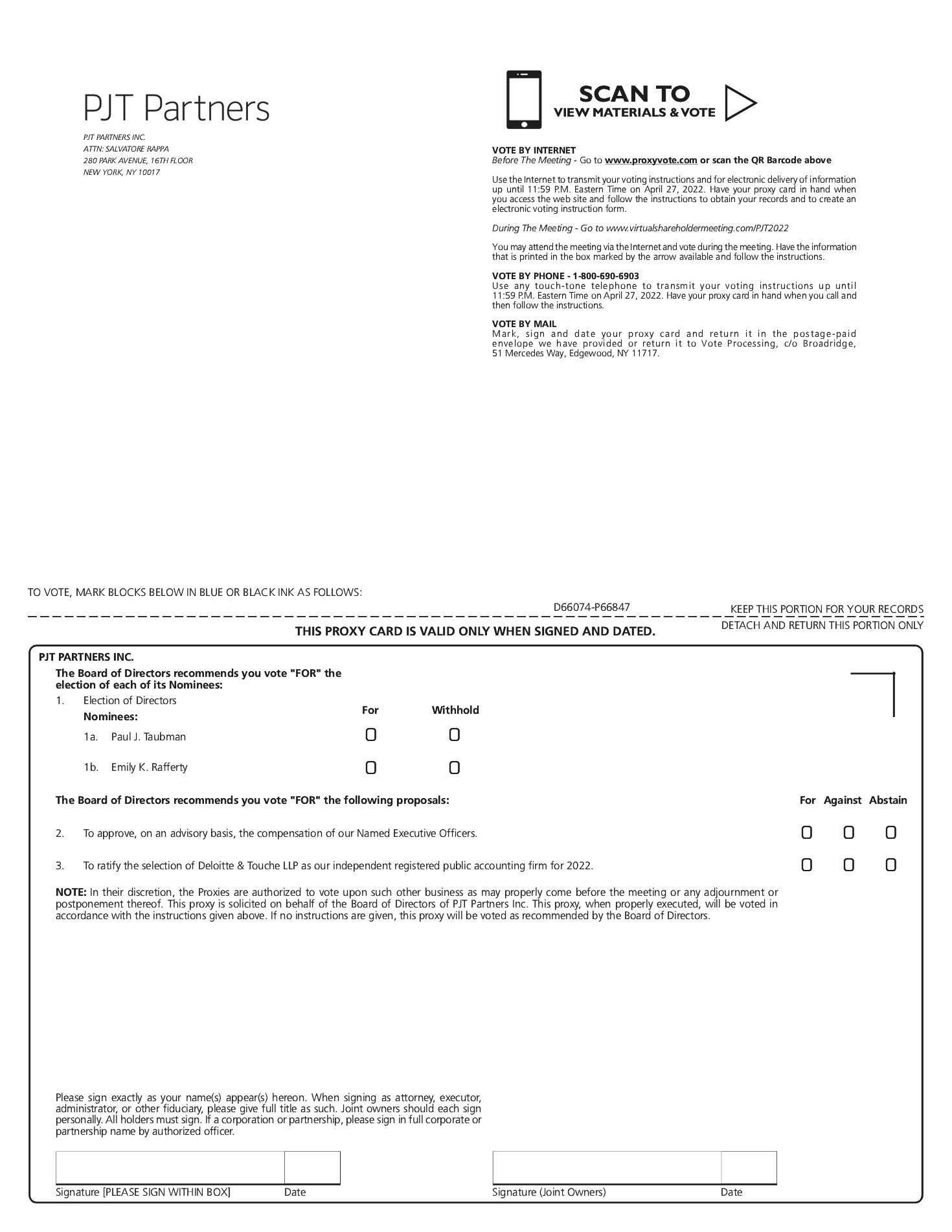The Performance LTIPs satisfy the time-vesting requirement over a five-year period, with 20% vesting per annum, with limited and customary vesting exceptions and forfeiture provisions provided in the applicable award agreement and the PJT Partners Inc. 2015 Omnibus Incentive Plan, such as change in control, death, disability and termination without cause.
| |
March 1, 2023 |
|
|
20% |
|
| |
March 1, 2024 |
|
|
40% |
|
| |
March 1, 2025 |
|
|
60% |
|
| |
March 1, 2026 |
|
|
80% |
|
| |
March 1, 2027 |
|
|
100% |
|
Performance LTIPs Granted to Mr. Taubman. In order to provide an appropriate link between compensation and the creation of shareholder value through long-term focused and retention-driven incentive awards, the Compensation Committee granted to Mr. Taubman 1,000,000 Performance LTIPs, with the performance and time-based vesting conditions as described above. The company does not currently anticipate paying Mr. Taubman any further equity incentive compensation through the end of 2026. Mr. Taubman’s annual base salary, which has been unchanged since 2015, will continue at $1,000,000 for 2022.
The following is a description of Mr. Taubman’s compensation framework from our spin-off in 2015 until the end of 2021. Mr. Taubman entered into a Partner Agreement with PJT Partners Holdings LP, commencing October 1, 2015, which provided for an annual base salary of $1,000,000 to be paid to Mr. Taubman through October 1, 2018 with no expectation of any further annual incentive compensation throughout the period of time. On September 24, 2018, the Compensation Committee agreed to extend Mr. Taubman’s annual base salary of $1,000,000 through October 1, 2021, and further awarded Mr. Taubman a grant of 60,000 LTIP Units that vested one-third ratably on each of October 1, 2019, 2020 and 2021, with no expectation of any further annual incentive compensation during the vesting period. Mr. Taubman has not otherwise received any additional incentive compensation recognizing year to year performance for over six years.
Performance LTIPs Granted to Ms. Lee, Ms. Meates and Mr. Travin. In order to align the interests of our executive officers with our shareholders in the same manner as Mr. Taubman, the Compensation Committee granted to Ms. Lee, Ms. Meates and Mr. Travin, 50,410, 41,146, and 16,212 Performance LTIPs, respectively. Performance LTIPs granted to Ms. Lee, Ms. Meates and Mr. Travin were granted as part of such Named Executive Officers’ performance year 2021 annual incentive compensation awarded as long-term incentives.
Other Compensation Highlights
Ms. Meates’s total awarded compensation specifically relating to 2021 remains unchanged from 2020. Ms. Meates is a key leader within the company and has played a critical role in the company’s growth since inception. Since 2015, the company’s revenue has increased by 144%, with adjusted pretax income increasing by 478% (see Appendix A for a reconciliation of this non-GAAP measure to its most directly comparable GAAP measure), and talent, as indicated by headcount growth, increasing by 136%. Rather than seeking to recognize Ms. Meates’s contribution to the company’s long-term growth on a year-to-year basis, our Chief Executive Officer, together with the Compensation Committee, have taken a longer-term perspective in acknowledging her contributions. With this longer-term reward philosophy


















